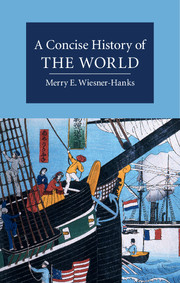Book contents
- Frontmatter
- Contents
- List of figures
- List of maps
- Introduction
- 1 Foraging and farming families (to 3000 BCE)
- 2 Cities and classical societies (3000 BCE–500 CE)
- 3 Expanding networks of interaction, 500 CE–1500 CE
- 4 A new world of connections, 1500 CE–1800 CE
- 5 Industrialization, imperialism, and inequality, 1800 CE–2015 CE
- Index
4 - A new world of connections, 1500 CE–1800 CE
Published online by Cambridge University Press: 05 October 2015
- Frontmatter
- Contents
- List of figures
- List of maps
- Introduction
- 1 Foraging and farming families (to 3000 BCE)
- 2 Cities and classical societies (3000 BCE–500 CE)
- 3 Expanding networks of interaction, 500 CE–1500 CE
- 4 A new world of connections, 1500 CE–1800 CE
- 5 Industrialization, imperialism, and inequality, 1800 CE–2015 CE
- Index
Summary
In 1503, the Florentine trader and explorer Amerigo Vespucci (1454–1512) wrote to his former employers, the Medici banking family, detailing in vivid language the mapping expedition sponsored by the Portuguese in which he had been involved over the previous several years. This voyage sailed along the coast of a large land mass across the Atlantic Ocean from Portugal, which Vespucci in the opening paragraph of the letter called a “new world, because none of these countries were known to our ancestors” and extolled as “a continent full of animals and more populous than our Europe, or Asia, or Africa, and even more temperate and pleasant than any other region known to us.” This letter and a subsequent even longer one were published many times in different European languages over the next several years. Among those who read them was the German map-maker Martin Waldseemüller (1470?–1522?), who in 1507 printed a globe and a giant wall map of the world in which the land mass Vespucci had helped map was not connected to any other. Waldseemüller gave the southern part of this landmass a name: America, taken from the Latin form of Vespucci's first name. He justified this with the comment, “I see no reason why, and by what right, this land of America should not be named after that wise and ingenious man who discovered it, Amerigo, since both Europe and Asia had been allotted the names of women.” (Europa and her mother Asia were Greek demi-goddesses.) By just a few years later, map-makers—including Waldseemüller—and others knew this was wrong, and that Christopher Columbus (1451–1506) had reached the continent before Vespucci; they wanted to omit “America” from future maps, but the name had already stuck. The Flemish cartographer, mathematician, and instrument maker Gerardus Mercator (1512–94), who invented the projection most commonly used to show the globe on a flat surface, used the word America on his world map of 1538, and later the designations “North” and “South” were added.
To the people who already lived there, of course, Vespucci's designation of what he had mapped as a “New World” was no more accurate than Waldseemüller's claim that Vespucci was the first European to see it.
- Type
- Chapter
- Information
- A Concise History of the World , pp. 210 - 285Publisher: Cambridge University PressPrint publication year: 2015



